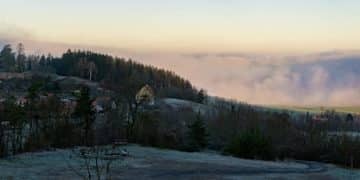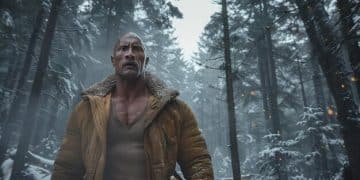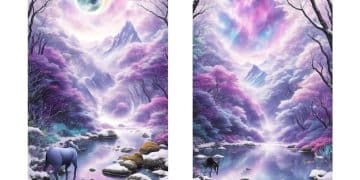Unveiling The Witcher’s World: Filming Locations & Production Design
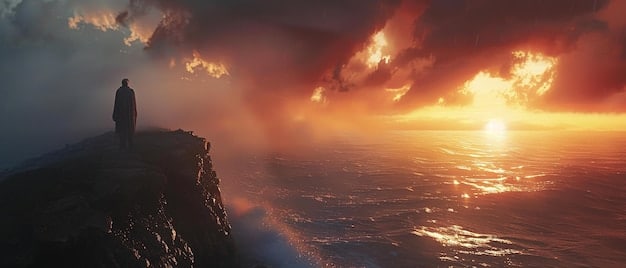
Netflix’s ‘The Witcher’ captivates audiences with its stunning visuals and immersive world; much of its magic stems from its carefully selected filming locations and intricate production design, which bring Andrzej Sapkowski’s fantasy novels to life.
Netflix’s ‘The Witcher’: A Look at the Show’s Filming Locations and Production Design transports viewers to a fantastical realm brimming with monsters, magic, and political intrigue. But beyond the captivating narrative, the series’ visual appeal plays a crucial role in its immersive storytelling. Let’s explore how the show’s stunning locations and intricate production design contribute to the overall experience.
The Allure of Authentic Locations
The production team behind ‘The Witcher’ made a conscious decision to prioritize real-world locations over extensive CGI backdrops. This approach lends the series a palpable sense of authenticity, grounding the fantastical elements in reality.
By choosing to film in diverse and visually striking locations, the showrunners have successfully created a world that feels both familiar and otherworldly.
Eastern Europe: The Heart of The Continent
Much of ‘The Witcher’ was filmed in Eastern Europe, leveraging the region’s diverse landscapes and rich history to create the fictional Continent. Countries like Poland, Hungary, and Slovakia provided backdrops for various kingdoms and settlements.
The use of genuine castles, forests, and historical sites enhances the viewing experience, allowing viewers to fullyimmerse themselves in Geralt’s world.
Iconic Locations in Detail
Several specific locations have become synonymous with ‘The Witcher,’ each contributing to the show’s distinctive aesthetic. These locations showcase the show’s commitment to visual storytelling.
- Ogrodzieniec Castle, Poland: Serving as the backdrop for the Battle of Sodden Hill, this ruined medieval castle provided an imposing and dramatic setting for the pivotal battle.
- Skladaná Skala, Slovakia: These unique rock formations feature in many scenes adding a mysterious aspect to the landscape.
- Canary Islands, Spain: Particularly La Palma, provided diverse landscapes, from volcanic terrain to lush forests to fit the requirements of the continent.
- Mafic Quarry (El Bufadero), Gran Canaria: This unique geological rock formation became the site of the portal where Yennefer meets Istredd in season one.
These locations, among others, have become instantly recognizable to fans of the series, further blurring the lines between fantasy and reality.
The careful selection of filming locations played a vital role in defining the visual identity of ‘The Witcher,’ imbuing the show with a sense of realism and grandeur. The authenticity created by these settings significantly enhances the immersive experience for viewers.
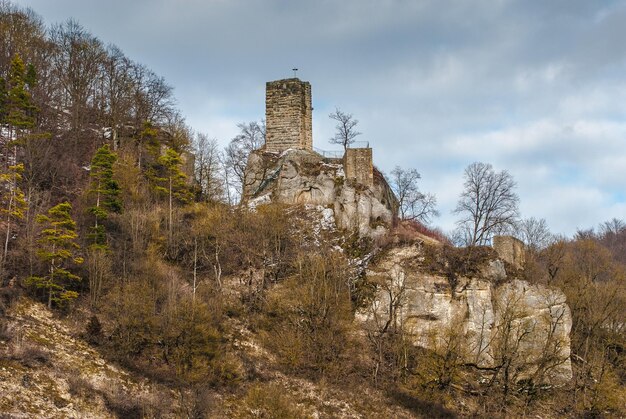
Crafting the Visual Language of The Witcher
Beyond the stunning locations, ‘The Witcher’ boasts a meticulously crafted production design that brings the world of the Continent to life. From the costumes to the set pieces, every detail is carefully considered to create a cohesive and believable visual experience.
The show’s production design team drew inspiration from a variety of sources, including medieval history, Slavic folklore, and the original novels by Andrzej Sapkowski. This diverse range of influences is evident in the show’s distinctive aesthetic.
Delving into Set Design and Costumes
The sets of ‘The Witcher’ range from grand castles to humble peasant villages, accurately reflecting the diversity of the Continent. Costumes follow the same diversity, each outfit telling the story of the person or culture wearing it.
Every element of the production design is painstakingly crafted to enhance the storytelling and immerse viewers in the world.
Key Elements of Production Design
The production design of ‘The Witcher’ encompasses a wide range of elements, each contributing to the show’s overall visual identity. It’s the combination of these aspects which sets the show apart.
- Costume Design: Costume designers use authentic materials and intricate detailing to bring depth and realism to the characters’ wardrobes.
- Set Decoration: From medieval tapestries to rustic furniture, every set piece is carefully chosen to create a believable and immersive environment.
- Creature Design: The monsters of ‘The Witcher’ are brought to life through a combination of practical effects, CGI, and detailed designs.
- Weaponry and Props: Each sword, potion, and amulet is crafted with attention to detail, reflecting the world’s lore and history.
The production design of ‘The Witcher’ blends seamlessly with the real-world locations, creating a visually stunning and believable world. This attention to detail contributes significantly to the show’s immersive storytelling.
The production design plays an integral role in shaping the viewer’s perception of the Continent, creating a world that feels both fantastic and believable. Every element, from the costumes to the sets, is carefully considered to enhance the storytelling and immerse the audience in Geralt’s world.
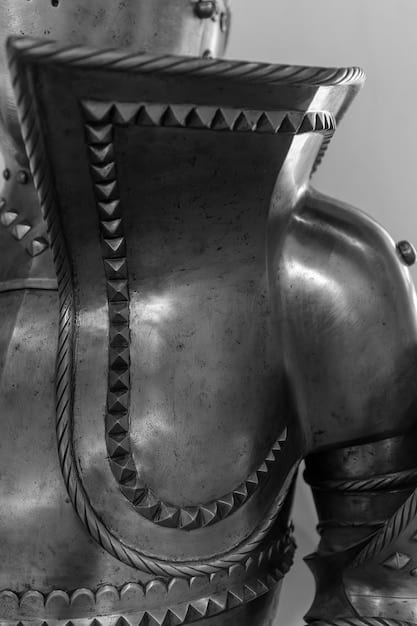
Impact on Storytelling and Immersion
The convergence of realistic filming locations and striking production design significantly impacts the storytelling and level of immersion experienced by viewers. It allows for heightened engagement with the world.
By grounding the series in reality through authentic locations and careful designs, the showrunners have created a world which is easier for viewers to connect with. This relatability is central to the show’s success.
Enhancing Believability and Engagement
The use of actual locations and painstakingly detailed production design dramatically enhances the believability of ‘The Witcher.’ The tangible and realistic feel of sets fosters heightened levels of engagement with the show.
When viewers can see and feel the dirt, stone, and textures of the Continent, it becomes much easier to suspend disbelief and fully immerse themselves in the narrative.
Visual Storytelling Techniques
Visual storytelling plays an important, integral role in ‘The Witcher,’ imbuing scenes with layers of meaning and emotion that enhance the audience’s perception of the show.
- Color Palettes: The deliberate use of color palettes can reflect the mood and tone of different regions and storylines.
- Set Design as Character: The sets can also inform the viewer about cultural details and give insights into the characters, their background and motivations.
- Costume Symbolism: The unique and often bold fashion statements are not always simply due to style but communicate to the watcher about the characters and their allegiances.
These visual clues communicate information and emotions, enriching the storytelling experience and reinforcing the audience’s immersion in the world of ‘The Witcher.’
The combined impact of location authenticity and detailed production design on storytelling and engagement cannot be overstated. By prioritizing visual storytelling, the showrunners have created a series that is both aesthetically pleasing and emotionally resonant.
Challenges of Location Filming and Design
While location filming and production design contribute significantly to the success of ‘The Witcher,’ the process is not without its challenges. Logistical hurdles, budgetary constraints, and creative compromises are some of the common obstacles faced by the production team.
Overcoming these challenges requires meticulous planning, creative problem-solving, and a dedicated team committed to bringing the world of ‘The Witcher’ to life.
Logistical and Budgetary Constraints
Filming in remote locations often presents logistical challenges, such as transportation, accommodation, and access to facilities. Such hurdles can impact the overall budget and timeline of the project.
Securing permits, managing local resources, and adhering to environmental regulations are all additional factors that must be considered.
Compromises and Creative Adaptations
Sometimes, the production team must make creative compromises to suit budgetary constraints or logistical limitations. Such decisions can often impact the authenticity of the visuals.
Finding innovative ways to adapt existing locations and designs while still retaining the essence of the source material is a critical skill for any production designer.
Maintaining Authenticity
Despite the challenges, the team are committed to maintaining authenticity in their designs.
- Thorough research into Slavic and European medieval fashion.
- Sourcing authentic materials, from local tradespeople.
- Balancing reality with fantasy elements.
These considerations assist in the creation of a believable, realistic world.
Successfully navigating these challenges requires a talented and dedicated team, meticulous planning, and a willingness to embrace creative solutions. Despite the obstacles, the end result is a series that is both visually stunning and deeply immersive.
Future Trends in Fantasy Filming and Design
As technology continues to evolve, the landscape of fantasy filmmaking and production design is constantly changing. Virtual production, AI-assisted design, and sustainable practices are just some of the trends that are poised to shape the future of the genre.
These technological advancements offer exciting possibilities for creating even more immersive and visually stunning worlds in the years to come.
Virtual Production and AI-Assisted Design
Virtual production techniques, such as LED walls and real-time rendering, allow filmmakers to create complex environments and visual effects in-camera, reducing the need for extensive post-production work. AI driven programmes speed up the design process.
AI-assisted design tools can also assist in generating concept art, designing sets, and creating realistic textures.
Sustainable Practices in Filmmaking
As environmental awareness grows, sustainable practices are becoming increasingly important in the film industry. Greener filming options may impact film-making in the following ways:
- Reducing on-location filming.
- Local sourcing of food, materials, props and design teams.
- Reducing waste.
These new approaches have the end result of reducing the carbon footprint of large productions.
By embracing these trends, filmmakers can unlock new creative possibilities, reduce costs, and create more sustainable and environmentally responsible productions. The future of fantasy filmmaking is bound to be both innovative and exciting.
Fan Engagement and Location Tourism
The popularity of ‘The Witcher’ has led to a surge in fan engagement and location tourism, as fans seek to experience the world of the Continent firsthand. This phenomenon highlights the power of visual storytelling to inspire and connect people.
The increase in tourism to locations seen in ‘The Witcher’ has provided economic benefits to the areas.
The Rise of Witcher Tourism
Fans are increasingly drawn to visit the real-world locations featured in ‘The Witcher,’ such as Ogrodzieniec Castle in Poland and the Canary Islands in Spain. This surge in tourism has resulted in significant benefits for the local economies and communities.
Tour operators now offer dedicated ‘Witcher’ tours, allowing fans to explore the iconic locations and immerse themselves in the world of the series.
Fan Communities and Online Engagement
The passionate fan base of ‘The Witcher’ has formed vibrant online communities, sharing their thoughts, theories, and fan-made content. These online spaces serve as hubs for discussions about the show’s locations, production design, and visual storytelling.
Social media platforms have also become important channels for fans to engage with the showrunners and production team, sharing their appreciation for the series’ visual elements.
The enduring popularity of ‘The Witcher’ and its impact on fan engagement and location tourism is a testament to its captivating storytelling and immersive visual world. The series has not only entertained millions of viewers but also inspired them to explore the real-world locations that bring the Continent to life.
| Key Point | Brief Description |
|---|---|
| 🌍 Filming Locations | Real-world locations in Eastern Europe and elsewhere enhance authenticity. |
| 🎨 Production Design | Detailed costumes, sets, and props create a cohesive visual experience. |
| ✨ Storytelling Impact | Visual elements amplify storytelling and viewer immersion. |
| 💰 Location Tourism | Popular filming locations see a rise in tourism with benefits for the local economy. |
Frequently Asked Questions
▼
The Witcher was primarily filmed in Eastern Europe, utilizing locations in countries like Poland, Hungary, and Slovakia for their diverse landscapes and historical settings, which help bring the Continent to life.
▼
Iconic locations include Ogrodzieniec Castle in Poland (Battle of Sodden Hill), Skladaná Skala in Slovakia and the Canary Islands in Spain. Each of these helped create the look and feel of The Continent.
▼
The meticulous production design includes every detail, from costumes to set pieces, all carefully designed to create a cohesive and believable visual experience, drawing from medieval history and Slavic folklore to add depth.
▼
The production team faced logistical challenges, budgetary constraints, securing permits and had to make creative compromises to overcome limitations, all while adhering to environmental regulations and maintaining visual authenticity.
▼
The series’ popularity has sparked a surge in tourism to filming locations, benefiting local economies and communities. Tour operators offer dedicated excursions, enabling fans to immerse themselves in the world of ‘The Witcher’.
Conclusion
The combination of real-world filming locations and detailed production design creates the immersive world of Netflix’s ‘The Witcher’: A Look at the Show’s Filming Locations and Production Design and the show’s compelling storytelling. Prioritizing authenticity and visual storytelling enhances believability, deepens fan engagement, and increases tourism to filming locations featured in the show.

